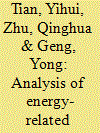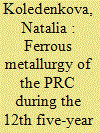| Srl | Item |
| 1 |
ID:
121291


|
|
|
|
|
| Publication |
2013.
|
| Summary/Abstract |
With China's increasing pressures on reducing greenhouse gas (GHG) emission, Chinese iron and steel industry (ISI) is facing a great challenge. In this paper, we address the energy-related GHG emission trajectories, features, and driving forces in Chinese ISI for 2001-2010. First, energy related GHG inventory for ISI is made for both scope 1 (direct emissions) and scope 2 (including imported electricity emission). Then, the driving forces for such emission changes are explored by utilizing the method of logarithmic mean Divisa index (LMDI) decomposition analysis. Results indicate that Chinese ISI experienced a rapid growth of energy related GHG emission at average annual growth rate of 70 million tons CO2e. Production scale effect is the main driving factor for energy related GHG emission increase in Chinese ISI, while energy intensity effect and emission factor change effect offset the total increase and energy structure has marginal effect. Construction, manufacture of general purpose and special purpose machinery and manufacture of transport equipment sectors are main sectors for embodied emissions, amounting for more than 75% of the total embodied emissions from Chinese ISI. Such research findings propose that a detailed consideration can help make appropriate polices for mitigating ISI's energy-related GHG emission.
|
|
|
|
|
|
|
|
|
|
|
|
|
|
|
|
| 2 |
ID:
118836


|
|
|
|
|
| Publication |
2013.
|
| Summary/Abstract |
This paper used data from 50 enterprises in China's iron and steel industry to evaluate their energy efficiency and productivity change. The study first used a conventional data envelopment analysis model and the Malmquist Productivity Index (MPI) to measure the energy efficiency and productivity change over the period 2001-2008. The results indicated inefficiency in many of the plants: The average energy efficiency was only 61.1%. The annual growth rate of productivity was 7.96% over this period and technical change was the main contributor to this growth. The research then took undesirable outputs into consideration by using the Malmquist-Luenberger Productivity Index (MLPI) to explore the productivity change from 2006 to 2008. Omitting undesirable outputs would result in biased efficiency change and technical change. This paper also claimed that environmental regulation has a potentially positive impact on technical change.
|
|
|
|
|
|
|
|
|
|
|
|
|
|
|
|
| 3 |
ID:
151264


|
|
|
|
|
| Summary/Abstract |
The author examines development problems of the PRC iron and steel industry. In order to create conditions for economic growth and facilitates greater competitiveness of Chinese producers on the world markets, modernization of the metallurgical complex is a priority task.
|
|
|
|
|
|
|
|
|
|
|
|
|
|
|
|
| 4 |
ID:
128375


|
|
|
|
|
| Publication |
2014.
|
| Summary/Abstract |
Germany produces more steel than any other European country (42.7 Mt steel in 2012). The steel production accounts for 22% of Germany's final industrial energy consumption. We assessed the potential of 32 identified energy conservation measures by deriving fuel, electricity and CO2 conservation cost curves. We developed a methodology which respects the current efficiency of individual plants and two different system boundaries: a process boundary for benchmarking measures and a facility boundary for calculating the total energy conservation potential. With moderate electricity and carbon price developments for the investigation period 2013-2035, the cost-effective conservation potentials are estimated to be 11.7% for fuel, 2.2% for electricity and 12.2% for fuel and process-related CO2 emissions compared to the industry's final energy use and CO2 emissions in 2012. For the sensitivity analysis, we varied electricity and carbon prices and our results showed that adopting cost-effective energy conservation measures can compensate for rising energy prices but the extent differs between the production routes. While the EAF route could compensate up to 50% higher electricity prices, the options for the BF/BOF route to reduce the fossil fuel consumption are limited. Thus, the energy-related production costs of the BF/BOF route increased in average by 6-13% between 2013 and 2035.
|
|
|
|
|
|
|
|
|
|
|
|
|
|
|
|